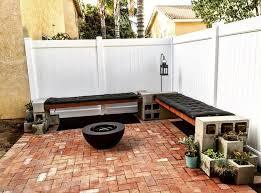Cinder Block Bench: Stylish, Durable, and Budget-Friendly Outdoor Seating

A cinder block bench is more than just a functional piece of outdoor furniture; it’s a versatile and budget-friendly option that adds a unique touch to any garden or patio. With its straightforward construction and customizable design, a cinder block bench can be a perfect fit for various outdoor spaces. This article explores the many benefits of a cinder block bench, provides design and building tips, and offers maintenance advice to ensure your bench remains a focal point of your outdoor area for years to come.
Benefits of a Cinder Block Bench
Durability and Longevity
One of the most significant advantages of a cinder block bench is its exceptional durability. Cinder blocks are made from concrete and are designed to withstand harsh weather conditions, including heavy rain, snow, and intense sunlight. Unlike wooden benches that can rot or metal benches that may rust, cinder block benches are highly resistant to the elements. This durability ensures that your bench will remain in excellent condition even after years of exposure to outdoor conditions.
Furthermore, cinder blocks are resistant to pests such as termites and ants, which can often damage other types of outdoor furniture. This resistance extends the life of the bench, reducing the need for frequent replacements or repairs. Additionally, the heavy weight of cinder blocks provides stability, making the bench less likely to tip over or shift, which is particularly advantageous in windy areas or high-traffic locations.
Cost-Effectiveness
Another compelling reason to choose a cinder block bench is its cost-effectiveness. Cinder blocks are relatively inexpensive compared to other materials used in outdoor furniture, such as wood, metal, or high-end composites. This affordability makes it an attractive option for those looking to enhance their outdoor space without breaking the bank. The low cost of cinder blocks does not compromise quality, as these blocks offer substantial strength and durability at a fraction of the price of more traditional materials.
Additionally, the DIY nature of constructing a cinder block bench allows for further cost savings. Many homeowners opt to build their benches themselves, which eliminates labor costs and provides a sense of accomplishment. Even if you choose to hire a professional, the overall cost remains lower compared to custom-built or pre-fabricated outdoor furniture.
Versatility and Customization
Cinder block benches offer unparalleled versatility and customization options. You can design your bench to suit your specific needs and preferences, whether you want a minimalist look or a more decorative piece. The modular nature of cinder blocks allows for various configurations, such as L-shaped benches, straight benches, or even corner seating arrangements.
Moreover, cinder block benches can be easily customized with paint, stains, or finishes to match your outdoor decor. You can also incorporate cushions, throw pillows, or fabric covers to enhance comfort and style. For those who enjoy gardening, integrating planters or incorporating climbing plants into the design can add a touch of greenery and make your bench an integral part of your garden landscape.
Designing Your Cinder Block Bench
Choosing the Right Location
When designing your cinder block bench, the first step is selecting the optimal location. Consider factors such as the size of your outdoor space, the desired function of the bench, and the overall aesthetic you want to achieve. For instance, if you plan to use the bench for entertaining guests, positioning it near a patio or dining area might be ideal. Alternatively, if you want a quiet spot for relaxation, placing the bench in a secluded corner of your garden could be more suitable.
Additionally, it’s essential to consider the ground surface where the bench will be placed. Ensure that the area is level and stable to prevent the bench from wobbling or shifting. If the ground is uneven, you may need to prepare a solid base or use leveling materials to ensure proper support for the cinder blocks.
Design Options and Styles
The design options for a cinder block bench are virtually limitless, allowing you to create a piece that perfectly complements your outdoor space. You can choose from various styles, such as contemporary, rustic, or industrial, depending on your preference. For a modern look, opt for a sleek, straight bench with clean lines and minimal embellishments. Alternatively, a rustic design featuring weathered finishes and natural elements can add charm and warmth to your garden.
Consider incorporating additional features into your design, such as built-in storage or integrated lighting. Some homeowners even choose to create multi-functional benches that serve as both seating and a table or planter. By experimenting with different configurations and materials, you can craft a unique and personalized piece that enhances the functionality and visual appeal of your outdoor area.
Adding Comfort and Aesthetics
To make your cinder block bench more comfortable and visually appealing, consider adding cushions, covers, or other decorative elements. Outdoor cushions are available in various colors, patterns, and materials, allowing you to coordinate with your existing decor. Choose weather-resistant fabrics to ensure longevity and easy maintenance.
You can also enhance the bench’s appearance by adding throw pillows, which provide extra comfort and a touch of style. Fabric covers can be used to protect the cushions and add an additional layer of customization. For a more polished look, consider using a bench cushion that fits the dimensions of the seat, providing both comfort and a cohesive design.
Building a Cinder Block Bench
Tools and Materials Needed
Building a cinder block bench requires a few essential tools and materials. Start with a set of cinder blocks, which will form the primary structure of the bench. You’ll also need mortar or adhesive to secure the blocks in place, as well as a trowel for applying the mortar. Additional tools include a level to ensure that the bench is even, a tape measure for accurate dimensions, and a rubber mallet to adjust the placement of the blocks.
If you plan to add a wooden or cushioned top to your bench, you will need additional materials such as wood planks, screws, and a drill. For those who want a more decorative finish, consider paint, stain, or sealant to enhance the appearance of the cinder blocks and protect them from the elements.
Step-by-Step Construction Guide
Constructing a cinder block bench involves a straightforward process. Begin by measuring and marking the area where the bench will be placed. Lay out the cinder blocks in the desired configuration, ensuring that they are evenly spaced and aligned. Apply a layer of mortar or adhesive to the bottom of each block, then press them into place. Use a level to check for evenness and make adjustments as needed.
Once the base layer is set, continue building up the sides and back of the bench, following the same process. Allow the mortar to dry completely before adding any additional features, such as a wooden top or cushions. If you choose to add a top, secure it using screws or adhesive, ensuring that it is firmly attached and level.
Safety Tips and Best Practices
When building your cinder block bench, it’s essential to follow safety guidelines to ensure a successful and secure construction. Wear protective gloves and safety goggles to prevent injury from sharp edges or falling debris. Additionally, use a sturdy surface or workbench to support the blocks while assembling them.
Ensure that the bench is built on a stable and level surface to prevent shifting or tipping. Double-check all measurements and alignments before applying mortar to avoid errors that may affect the bench’s stability. If you are unsure about any aspect of the construction process, consider consulting a professional or seeking advice from experienced builders.
Maintaining and Enhancing Your Cinder Block Bench
Routine Maintenance
Maintaining a cinder block bench is relatively simple and involves regular cleaning and inspection. Use a mild detergent and water to clean the surface of the bench, removing any dirt, grime, or stains. A soft brush or cloth can help reach into crevices and corners. Avoid using harsh chemicals or abrasive cleaners, as these can damage the surface of the cinder blocks.
Inspect the bench periodically for any signs of damage, such as cracks or chips. Address any issues promptly to prevent further deterioration. If you notice any significant damage, such as structural instability, consider repairing or replacing affected blocks to ensure the bench remains safe and functional.
Enhancing with Plants and Decor
To further enhance your cinder block bench, consider incorporating plants and decorative elements into the design. Adding planters or garden boxes to the bench can create a lush and inviting atmosphere. Choose plants that complement your outdoor decor and thrive in your climate. Consider incorporating climbing plants or vines to add vertical interest and soften the appearance of the cinder blocks.
Decorative elements such as outdoor rugs, lanterns, or sculptures can also add visual interest and personalize the space around your bench. Experiment with different arrangements and accessories to create a cohesive and attractive outdoor setting.
Repair and Upkeep
Over time, a cinder block bench may require repairs to address any wear and tear. Common issues include cracked or chipped blocks, loose mortar, or damage to the bench top. To repair cracks or chips, use a concrete patching compound or sealant designed for outdoor use. Apply the compound according to the manufacturer’s instructions and allow it to dry completely before using the bench.
For loose mortar, remove any damaged or crumbling sections and reapply fresh mortar. Ensure that the mortar is evenly distributed and properly cured before using the bench. Regular upkeep and timely repairs will help extend the life of your cinder block bench and keep it looking its best.
Conclusion
A cinder block bench is an excellent addition to any outdoor space, offering durability, cost-effectiveness, and versatility. By carefully designing, building, and maintaining your bench, you can create a stylish and functional seating area that enhances your garden or patio. Whether you opt for a minimalist design or a more elaborate setup, a cinder block bench provides a unique and budget-friendly solution for your outdoor seating needs. Embrace the simplicity and strength of cinder blocks and enjoy a lasting and attractive addition to your home.





